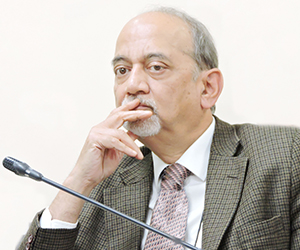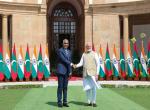Pakistan was already going through an economic slowdown when the COVID outbreak took place. It had received the US $ 6 billion of assistance from the IMF under Extended Fund Facility last year. The money came with conditions. The IMF policy of inflation targeting led to fiscal and monetary contraction. The painful economic restructuring needs political consensus to cope with. Prime Minister Imran Khan’s priorities seem to be a political vendetta. He came to power on a promise of expanded social service, housing, and job creation. The austerity package and post-pandemic slowdown will make the common man’s situation worse in ‘Naya Pakistan’.
The World Bank has downgraded Pakistan’s growth forecast to negative 2.6 percent for the coming year. This is 5 percent below the rate projected by the IMF/World Bank in July 2019.1 The Government of Pakistan has also revised downward growth projection, but it is still more optimistic than the World Bank estimate. It has brought down the growth estimate from 2.4 percent in the pre-COVID budget to negative 0.38 percent as on May 2020. 2 Pakistan follows the June-July financial year cycle. The above projections are for the financial year beginning in July 2020. For the current financial year, the State Bank of Pakistan has an estimated negative growth rate of 1.5 percent.
Prime Minister Imran Khan announced an economic stimulus package of Rs. 1.25 trillion on March 24, 2020. At 1 US $ = 160 Pakistani rupees (approximate), this works out to around US$ 8 billion. According to one estimate, out of this amount, only Rs.519 billion are additionality. The revenue target of Rs.5.5 trillion has been lowered to Rs.4.95 trillion by the IMF. The government’s projection is only Rs.3.9 trillion.3 Pakistan also asked the international community to do more. ‘The IMF approved the disbursement of US $ 1.384 billion under the Rapid Financing Instrument to address the economic impact of the Covid-19 shock4 billion from the IMF in April.4 This is in the nature of the balance of payments support stemming from the outbreak of the COVID-19 pandemic.
Pakistan will also benefit from the G-20 decision to extend debt relief on all principal and interest payments to official bilateral creditors. Pakistan is amongst the 76 countries under the International Development Association (IDA) program of the World Bank. The debt relief will start from May 1 and continue till December 1, 2020. ‘All debt service falling due in this period will be packaged into a new loan on which the payment will not start until June 2022. Then it will be paid over the subsequent three years.’5 This actually could be a bigger concession than the disbursement of US$ 1.384 billion earlier announced in April 2020, since this will affect repayments of a large amount of debt burden of Pakistan. Pakistan has a total external debt of US $ 100 billion. According to Foreign Minister Qureshi, ‘Pakistan annually spends $ 10 to $12 billion on debt servicing.’6 To be fair to Prime Minister Imran Khan, this debt burden is the historical legacy left by the previous governments. But the IMF package and credit from bilateral lenders have added to the burden.
There is expected to be a sharp fall in remittances from Pakistani workers in the Middle East. The annual remittances of around US $ 21 billion go a long way in reducing the current account deficit. Pakistan usually runs a balance of trade deficit, and the FDI inflows are nominal. These were already showing a downward trend in the first quarter of 2020, which saw the remittances decline from the US $ 5918.0 million in the previous quarter to the US $ 5627.0 million in the quarter ending March 2020.7 Since then, there has been large scale repatriation of workers. It will take some time before the full measure of the impact crystallizes. This will depend not only on the COVID situation but recovery of oil demand and prices. Oil revenues are the main source for most of the Gulf countries with a large Pakistani expatriate population.
Pakistan has been treated with extra-ordinary generosity by international donors, including the IMF. This has instilled a belief that the only Muslim country with nuclear weapons will not be allowed by the international community to sink. Even then, the IMF program results in fiscal austerity. It has resulted in increasing unemployment even before the COVID struck. Most of the bank loans are not available in the absence of collaterals to the service sector, which accounts for 53 percent of Pakistan’s GDP. The worsening conditions may impact social cohesion.
Prime Minister Imran Khan initially dithered over the decision to declare a lock-down. Pakistan government pointedly decided to continue flights to China much after most countries had stopped them. This certainly made the problem worse, though the initial outbreak of COVID was largely blamed on Pakistani pilgrims returning from Iran through the overland route in Taftan, Balochistan. The complete lockdown since then has been lifted and replaced by the ‘smart lockdown’. This may not have boosted the economy, though the COVID rate has gone up. Pakistan has 113,585 confirmed COVID cases with 2,956 deaths so far. This makes the incidence of COVID cases in Pakistan three times that of India.
Out of a total number of COVID cases, Sindh accounts for 41,303 cases, Punjab 43,460 cases, KP 14,527 cases, and 444/974 cases for ‘AJK’/GB. In per capita terms, the highest incidence of COVID cases are in Gilgit-Baltistan. This is more than twice the average for Pakistan’s provinces. This is of course not a coincidence; the territory is the gateway to China.
Pakistan has a daunting challenge. The economic stimulus announced by the Prime Minister of nearly US$ 8 billion will need additional resources at a time when the estimate of revenue receipt has been lowered by 9 percent from Rs.5.5 trillion to Rs.4.95 trillion by the IMF. The government’s projection is nearly 30 percent lower at Rs. 3.9 trillion. The debt relief has postponed payment of debt-obligations arising between May-December 2020. But the waiver does not cover debt payments arising in the second half the budget year.
Though Pakistan has challenges, it is not without options. It played the facilitator for Doha Talks between the US and the Taliban last year. The Chinese interest in the China-Pakistan Economic Corridor (CPEC) is an expression of geopolitics. Will China be willing to continue investing in CPEC at a time of unprecedented slow-down in growth in that country? For the first time, the National Peoples’ Congress did not indicate any GDP growth numbers. It probably will sustain priority projects. Will it provide new commitments to its protégé? Pakistan’s biggest bilateral creditor is Saudi Arabia. It has suffered on account of the loss of volume as well as the price of export of crude oil. The prices will rise again when the global economy begins to recover.
Endnotes
- Business Recorder Editorial. Massive downward growth revision, June 10, 2020
- Business Recorder Editorial. Massive downward growth revision, June 10, 2020
- Business Recorder Editorial, IMF and the budget 2020-21
- IMF Press Release No 20/167.
- Daily Times, Pakistan gets one-year debt relief from IMF, June 10, 2020
- Ibid
- www.tradingeconomics’.com
(The paper is the author’s individual scholastic articulation. The author certifies that the article/paper is original in content, unpublished and it has not been submitted for publication/web upload elsewhere, and that the facts and figures quoted are duly referenced, as needed, and are believed to be correct). (The paper does not necessarily represent the organisational stance... More >>
Image Source: https://img.etimg.com/thumb/msid-76288150,width-300,imgsize-156839,resizemode-4/pakistan.jpg











Post new comment